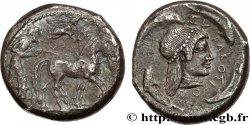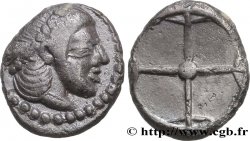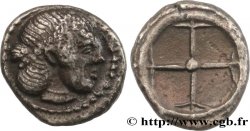bgr_354274 - SICILY - SYRACUSE Tétradrachme
Not available.
Item sold on our e-shop (2015)
Price : 1 500.00 €
Item sold on our e-shop (2015)
Price : 1 500.00 €
Type : Tétradrachme
Date: c. 480-475 AC.
Mint name / Town : Syracuse, Sicile
Metal : silver
Diameter : 26 mm
Orientation dies : 4 h.
Weight : 17,13 g.
Rarity : R3
Coments on the condition:
Exemplaire sur un flan ovale bien centré des deux côtés avec le grènetis visible au droit. Joli droit de style fin bien venu à la frappe. Joli revers de style fin avec un début de cassure de coin perceptible dans la chevelure. Jolie patine de collection ancienne avec des reflets doré
Catalogue references :
Obverse
Obverse legend : ANÉPIGRAPHE.
Obverse description : Bige au pas à droite, conduit par un aurige tenant les rênes et le kentron ; le bige est couronné par Niké volant à droite.
Reverse
Reverse legend : N RÉTROGRADE.
Reverse description : Tête d'Aréthuse à droite, les cheveux relevés et retenus par un diadème de perles, entourée de quatre dauphins.
Reverse legend : SURAKOS-IO-N.
Commentary
Même coin de revers que l’exemplaire de la vente Ars Classica V, Naville, n° 1020. Ce type semble beaucoup plus rare que ne le laisse apparaître la typologie. Cassure de coin caractéristique, bien visible sur l’ensemble de la chevelure donnant une impression de “vague”.








 Report a mistake
Report a mistake Print the page
Print the page Share my selection
Share my selection Ask a question
Ask a question Consign / sell
Consign / sell
 Full data
Full data



